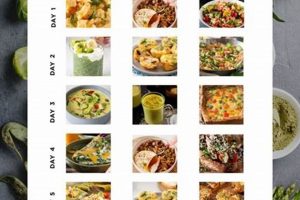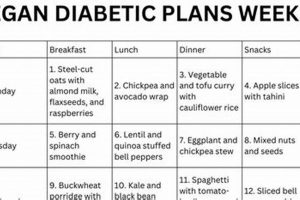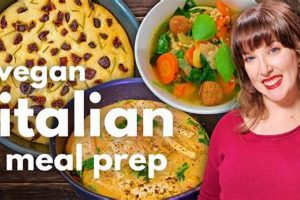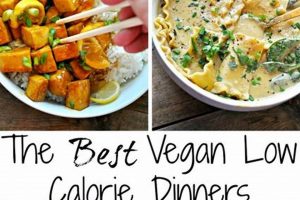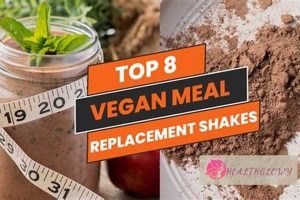Plant-based diets devoid of cereals and pseudo-cereals offer a dietary approach focused on fruits, vegetables, legumes, nuts, seeds, and other non-grain carbohydrates. Such dietary patterns exclude wheat, rice, corn, oats, barley, rye, and related grains, along with any products derived from them. For example, a meal featuring lentil soup, a mixed green salad with avocado, and a side of roasted sweet potatoes aligns with this dietary framework.
Adherence to a dietary regime that excludes both animal products and grains can present several potential advantages. Individuals may seek this type of eating pattern for various reasons, including managing sensitivities or allergies, addressing specific health conditions, or aligning with personal ethical or lifestyle choices. Historically, various cultures have relied heavily on non-grain staples, demonstrating the viability of such dietary approaches across different populations and time periods.
The following sections will delve into specific considerations for formulating balanced and nutritionally complete eating plans within this context. Emphasis will be placed on meeting macronutrient and micronutrient requirements, identifying suitable food sources, and addressing potential challenges associated with this dietary restriction.
Guidance for Grain-Free Vegan Diets
Adopting a dietary approach that eliminates both grains and animal products requires careful planning to ensure nutritional adequacy. The following guidance provides practical considerations for constructing balanced and sustainable eating patterns.
Tip 1: Prioritize Protein Sources: Legumes, such as lentils, beans, and peas, form the cornerstone of protein intake. Consume a variety of these throughout the week. Tofu, tempeh, and edamame also provide substantial protein contributions.
Tip 2: Diversify Vegetable Intake: A wide range of non-starchy vegetables should constitute a significant portion of the diet. Leafy greens, cruciferous vegetables, and colorful bell peppers offer essential vitamins, minerals, and fiber.
Tip 3: Incorporate Healthy Fats: Avocados, nuts, seeds, and olive oil are crucial sources of essential fatty acids. Be mindful of portion sizes, as nuts and seeds are calorie-dense.
Tip 4: Address Vitamin B12 Needs: Vitamin B12 is not naturally found in plant-based foods, necessitating supplementation or consumption of fortified products. Consult with a healthcare professional regarding appropriate dosage.
Tip 5: Monitor Iron Levels: Plant-based iron (non-heme iron) is less readily absorbed than animal-based iron. Enhance absorption by consuming iron-rich foods with vitamin C, such as citrus fruits or bell peppers.
Tip 6: Consider Calcium Intake: Leafy green vegetables (kale, collard greens), fortified plant milks, and tofu processed with calcium sulfate can contribute to calcium intake. Ensure adequate sunlight exposure for vitamin D synthesis, which aids calcium absorption.
Tip 7: Optimize Fiber Consumption: Non-starchy vegetables, legumes, and fruits provide dietary fiber. Increase intake gradually to minimize digestive discomfort.
These guidelines underscore the importance of informed dietary planning when eliminating grains and animal products. Attention to protein, micronutrient, and fiber intake is crucial for maintaining overall health and well-being.
The subsequent sections will explore potential challenges associated with these dietary restrictions and offer strategies for overcoming them.
1. Nutrient Density
In the context of grain-free, plant-based eating patterns, nutrient density assumes paramount importance. The exclusion of grains, which can contribute significantly to micronutrient and macronutrient intake in conventional diets, necessitates a deliberate focus on selecting foods that maximize nutrient content per calorie. This is a cause-and-effect relationship: removing a dietary staple mandates increased reliance on other sources to meet nutritional needs. For example, if whole grains, a common source of B vitamins and minerals, are absent, a higher intake of dark leafy greens, legumes, and nuts becomes crucial to compensate.
The practical significance of understanding nutrient density within a grain-free vegan framework lies in preventing nutritional deficiencies. Simply removing grains and animal products without strategic food selection can lead to inadequate intake of essential nutrients like iron, calcium, vitamin B12, and omega-3 fatty acids. Consider the challenge of obtaining sufficient iron: plant-based iron is less readily absorbed than heme iron from animal products. Consequently, individuals following this dietary pattern must consume iron-rich foods, such as spinach and lentils, alongside vitamin C-rich foods like bell peppers, to enhance absorption. This highlights the need for informed choices beyond merely adhering to dietary restrictions.
Achieving optimal nutrient density in grain-free vegan meal plans requires careful planning and a commitment to dietary diversity. The challenge lies in ensuring that each meal contributes meaningfully to the overall nutritional profile. Failure to prioritize nutrient-dense foods can result in suboptimal health outcomes. Therefore, a comprehensive understanding of the nutritional composition of various plant-based foods and their synergistic interactions is essential. This approach promotes sustained health and well-being by mitigating potential nutritional deficits associated with restrictive diets.
2. Protein Sources
In the formulation of grain-free vegan dietary plans, the identification and strategic incorporation of adequate protein sources assumes paramount importance. Given the exclusion of both animal-derived proteins and many plant-based foods commonly relied upon for protein intake (such as wheat-based products), careful consideration of alternative protein sources is essential to meet physiological requirements.
- Legume Selection
Legumes, encompassing lentils, beans, and peas, constitute a primary protein source. Each variety exhibits a unique amino acid profile; therefore, a diverse intake of legumes is recommended to ensure a complete array of essential amino acids. For instance, combining lentils (rich in lysine) with brown rice (rich in methionine) provides a complementary protein profile. In the absence of grains, alternative sources of methionine must be prioritized, such as nuts and seeds.
- Soy-Based Alternatives
Soy-based products, including tofu, tempeh, and edamame, offer complete protein profiles and are versatile culinary ingredients. Tofu, derived from condensed soy milk, can be prepared in various textures and flavors. Tempeh, a fermented soy product, provides a firmer texture and a slightly nutty flavor. Edamame, immature soybeans, can be consumed as a snack or incorporated into salads and stir-fries. The inclusion of these ingredients contributes significantly to meeting protein targets in grain-free vegan diets.
- Nuts and Seeds
Nuts and seeds, while also valuable sources of healthy fats and micronutrients, contribute to overall protein intake. Almonds, walnuts, chia seeds, and flax seeds offer varying amounts of protein. However, they are not complete proteins on their own and should be consumed in conjunction with other protein sources to ensure a balanced amino acid intake. Furthermore, mindful portion control is necessary, given the caloric density of nuts and seeds.
- Nutritional Yeast
Nutritional yeast, a deactivated yeast with a savory, cheesy flavor, can be used to enhance the palatability of grain-free vegan dishes while also providing a source of protein and B vitamins. It is often fortified with vitamin B12, an essential nutrient not naturally found in plant-based foods. Nutritional yeast can be sprinkled on vegetables, added to sauces, or used as a cheese substitute in various recipes.
The strategic selection and integration of these protein sources are critical for formulating nutritionally sound grain-free vegan meal plans. Failure to prioritize protein intake can lead to muscle loss, impaired immune function, and other adverse health outcomes. Therefore, individuals adhering to this dietary pattern should carefully monitor their protein intake and ensure the consumption of a diverse range of plant-based protein sources to meet their individual needs.
3. Fiber adequacy
The concept of fiber adequacy within a grain-free, plant-based dietary framework presents a multifaceted consideration. While grains are often recognized as significant sources of dietary fiber, their exclusion does not inherently compromise fiber intake. A properly constructed grain-free vegan diet can, and should, provide ample fiber through alternative sources such as vegetables, fruits, legumes, nuts, and seeds. The direct effect of eliminating grains necessitates a compensatory increase in the consumption of these other fiber-rich foods to maintain digestive health and overall well-being. For example, replacing a serving of whole-wheat bread with a larger serving of broccoli, lentils, or berries can readily fulfill the fiber requirement.
The importance of adequate fiber intake stems from its multifaceted physiological roles. Fiber promotes digestive regularity, aids in blood sugar control, contributes to satiety, and may lower cholesterol levels. These benefits are particularly salient in the context of a vegan diet, where the absence of animal products necessitates careful attention to the intake of nutrients traditionally associated with those food groups. For instance, individuals transitioning to a grain-free vegan diet may experience digestive irregularities if their fiber intake is not intentionally managed through increased consumption of non-grain plant sources. A practical application involves strategically planning meals to include a variety of high-fiber vegetables and legumes at each sitting. Smoothies incorporating leafy greens, chia seeds, and berries provide a concentrated source of fiber that can be easily integrated into daily routines.
In conclusion, while the elimination of grains requires a conscious effort to secure fiber from alternative sources, a well-designed grain-free vegan meal plan can readily achieve fiber adequacy. The success hinges on understanding the fiber content of various non-grain plant foods and integrating them strategically into daily meals. Challenges may arise from inadequate planning or a lack of awareness regarding suitable fiber sources, but these can be overcome through education and a commitment to dietary diversity. Prioritizing fiber intake through vegetables, fruits, legumes, nuts, and seeds is crucial for maintaining optimal health and digestive function within this dietary approach.
4. Mineral bioavailability
Mineral bioavailability, referring to the proportion of a mineral in food that is absorbed and utilized by the body, presents a critical consideration within the context of grain-free vegan diets. The absence of grains, which can contribute to mineral intake, coupled with inherent characteristics of plant-based foods, necessitates a nuanced understanding of factors influencing mineral absorption.
- Phytic Acid and Mineral Binding
Phytic acid, present in many plant foods such as legumes, nuts, and seeds, can bind to minerals like iron, zinc, and calcium, reducing their bioavailability. The degree of this binding is influenced by the amount of phytic acid in the diet and the presence of other dietary components. For example, soaking or sprouting legumes and seeds can reduce phytic acid content, thereby enhancing mineral absorption.
- Oxalates and Calcium Absorption
Oxalates, found in certain vegetables like spinach and rhubarb, can inhibit calcium absorption. While these vegetables provide calcium, the presence of oxalates limits the amount the body can utilize. Consuming oxalate-rich foods in moderation and ensuring adequate calcium intake from other sources, such as calcium-set tofu or fortified plant milks, is essential to mitigate this effect.
- Iron Absorption and Enhancers
Plant-based iron (non-heme iron) is less readily absorbed than heme iron from animal sources. However, absorption can be significantly enhanced by consuming vitamin C-rich foods alongside iron-containing plant foods. For instance, pairing lentils with bell peppers or tomatoes can improve iron bioavailability. Conversely, consuming tea or coffee with meals can inhibit iron absorption.
- Dietary Diversity and Mineral Balance
A diverse intake of plant-based foods is crucial for optimizing mineral status. Different foods contain varying levels of minerals and compounds that affect their absorption. Consuming a variety of vegetables, fruits, legumes, nuts, and seeds ensures a broader spectrum of minerals and can help balance the effects of absorption inhibitors. For example, while some foods may be high in phytic acid, others may be rich in absorption-enhancing compounds.
Addressing mineral bioavailability in grain-free vegan diets requires strategic meal planning and an awareness of food interactions. Methods like soaking, sprouting, and fermentation can reduce the impact of absorption inhibitors, while combining mineral-rich foods with absorption enhancers can further improve mineral status. The challenges posed by reduced bioavailability can be effectively managed through informed dietary choices and appropriate food preparation techniques.
5. Dietary diversity
Dietary diversity, characterized by the consumption of a wide variety of foods across and within food groups, assumes heightened importance within the context of grain-free vegan meal plans. The exclusion of both animal products and grains dietary staples for many individualsnecessitates a strategic approach to ensure adequate nutrient intake. The restriction, in effect, demands a broader consumption pattern across permitted food categories to compensate for the eliminated sources of vitamins, minerals, and macronutrients. Consequently, a lack of diversity in a grain-free vegan diet directly elevates the risk of nutrient deficiencies.
The significance of dietary diversity stems from its capacity to provide a complete spectrum of essential nutrients. Consider the challenge of obtaining sufficient vitamin B12, an essential nutrient not found naturally in plant-based foods. While supplementation or fortified foods are necessary, relying solely on a limited range of plant foods further increases the risk of other micronutrient deficiencies. Incorporating a wide array of vegetables, fruits, legumes, nuts, and seeds not only enhances the likelihood of meeting nutrient needs but also provides a broader range of phytochemicals and antioxidants, contributing to overall health and disease prevention. Examples of increasing diversity include incorporating various colored vegetables (e.g., red bell peppers, purple cabbage, orange carrots) and rotating legume varieties (e.g., lentils, chickpeas, black beans) throughout the week.
In summary, dietary diversity constitutes a cornerstone of successful grain-free vegan meal planning. Its practical significance lies in mitigating the risk of nutrient deficiencies associated with restrictive diets and promoting overall health through the consumption of a wide range of beneficial plant compounds. Challenges associated with achieving dietary diversity, such as limited access to diverse foods or lack of culinary knowledge, can be addressed through education and resource accessibility. Prioritizing diversity ensures that grain-free vegan diets are not only ethical and sustainable but also nutritionally complete.
6. Meal planning
Effective meal planning is a central component of adhering to grain-free vegan dietary patterns. The inherent restrictions of excluding both animal products and grains necessitate proactive strategies to ensure nutritional adequacy and prevent dietary monotony. Without careful planning, individuals risk nutrient deficiencies and may find it challenging to sustain adherence to this restrictive eating pattern over time. For example, haphazard meal selection may result in inadequate protein intake, necessitating a more structured approach that incorporates specific protein sources into each meal.
The importance of meal planning stems from its ability to address several key challenges. It facilitates the incorporation of diverse food groups, ensuring a wide range of vitamins and minerals. Pre-planned meals can also help manage portion sizes, promoting weight management and preventing overconsumption of calorie-dense foods like nuts and seeds. A practical example involves creating a weekly meal schedule with specific recipes and grocery lists. This allows for the systematic inclusion of legumes, vegetables, and healthy fats, mitigating the risk of nutritional imbalances. Furthermore, meal planning reduces the likelihood of impulsive food choices, which may not align with the dietary guidelines. Preparation of ingredients in advance further streamlines the meal preparation process, increasing convenience and adherence.
In summary, meal planning is not merely a logistical tool but a fundamental requirement for the successful implementation and maintenance of grain-free vegan diets. It provides a framework for ensuring nutritional adequacy, managing portion sizes, and promoting dietary adherence. While challenges may arise from time constraints or limited culinary skills, the benefits of proactive meal planning outweigh these obstacles, ultimately contributing to improved health and well-being. The effectiveness of meal planning relies on a comprehensive understanding of nutritional needs and a commitment to consistent preparation and execution.
7. Palatability
Palatability, the degree to which a food is pleasing or acceptable to the senses, is a critical determinant of long-term adherence to any dietary regimen, particularly one as restrictive as grain-free veganism. The omission of both animal products and grains significantly narrows the range of traditionally palatable options, requiring careful attention to flavor profiles, textures, and overall sensory appeal to ensure sustained dietary compliance.
- Flavor Development Through Herbs and Spices
Herbs and spices serve a crucial role in enhancing the palatability of grain-free vegan meals. Their application allows for the creation of complex and satisfying flavor profiles that compensate for the absence of familiar tastes often associated with grains and animal fats. For example, the use of smoked paprika and cumin can impart a savory depth to lentil-based dishes, while fresh herbs like basil and cilantro can brighten vegetable-based preparations. Strategic seasoning is essential to transform inherently bland ingredients into appealing and flavorful meals, counteracting the perception of deprivation often associated with restrictive diets.
- Textural Variety and Culinary Techniques
Textural monotony can significantly detract from the overall palatability of any meal. In grain-free vegan cooking, diverse textures are achieved through a combination of ingredient selection and culinary techniques. Roasting vegetables creates caramelized surfaces and tender interiors, while blending nuts and seeds into sauces adds creaminess. Utilizing techniques such as spiralizing vegetables to mimic pasta or creating crispy tofu through proper pressing and frying can introduce textural contrasts that enhance the eating experience. Addressing the textural dimension is vital for maintaining interest and satisfaction in grain-free vegan meals.
- Strategic Use of Healthy Fats
Fats contribute significantly to the palatability of food by enhancing flavor and providing a sense of satiety. While grain-free vegan diets exclude animal fats, healthy plant-based fats, such as those derived from avocados, nuts, seeds, and olive oil, can be strategically incorporated to improve the sensory appeal of meals. A drizzle of high-quality olive oil over roasted vegetables or the addition of avocado to a salad can elevate the dish’s palatability and contribute to a feeling of fullness. Careful selection and application of healthy fats are essential for creating satisfying and flavorful grain-free vegan meals.
- Visual Presentation and Aesthetic Appeal
The visual presentation of food plays a substantial role in its perceived palatability. A well-presented meal, with vibrant colors and appealing arrangement, can stimulate appetite and enhance the overall dining experience. Grain-free vegan meals can be visually enhanced through the use of colorful vegetables, artistic plating, and thoughtful garnishes. Simple techniques, such as arranging ingredients in a visually balanced manner or adding a sprinkle of fresh herbs, can significantly increase the perceived palatability of the dish, making it more appealing and enjoyable.
The multifaceted nature of palatability, encompassing flavor, texture, fat content, and visual presentation, underscores its importance in the context of grain-free vegan meals. Addressing these aspects through strategic ingredient selection and culinary techniques is crucial for ensuring that these dietary patterns are not only nutritionally adequate but also enjoyable and sustainable over the long term.
Frequently Asked Questions
The following section addresses common inquiries and clarifies misconceptions surrounding the adoption and implementation of grain-free vegan dietary plans.
Question 1: Are grain-free vegan meals nutritionally complete?
When carefully planned and executed, these eating patterns can provide all essential nutrients. Emphasis must be placed on consuming a diverse range of vegetables, fruits, legumes, nuts, and seeds to ensure adequate intake of vitamins, minerals, and essential amino acids. Supplementation with vitamin B12 is generally recommended.
Question 2: Can an individual obtain sufficient protein on a grain-free vegan diet?
Adequate protein intake is achievable through strategic incorporation of legumes, soy-based products (tofu, tempeh, edamame), nuts, and seeds. A varied intake of these sources throughout the day is necessary to meet protein requirements. Precise protein needs vary based on activity level and individual physiology.
Question 3: Is this dietary approach suitable for individuals with specific health conditions?
While potentially beneficial for certain conditions, such as gluten sensitivity or some autoimmune disorders, the suitability of a grain-free vegan diet should be determined in consultation with a qualified healthcare professional. Individuals with pre-existing health conditions should seek personalized guidance to ensure optimal health outcomes.
Question 4: Are there any potential risks associated with grain-free vegan meals?
Potential risks include nutrient deficiencies, particularly in iron, calcium, vitamin D, and omega-3 fatty acids, if the diet is not properly planned. Careful attention to food choices and supplementation, when necessary, is crucial to mitigate these risks. Digestive issues may also arise due to increased fiber intake; gradual incorporation of high-fiber foods is advised.
Question 5: Is a grain-free vegan diet sustainable long-term?
Long-term sustainability depends on individual preferences, dietary habits, and commitment to proper meal planning. Ensuring palatability, variety, and convenience is essential for maintaining adherence. Seeking support from registered dietitians or nutritionists can enhance long-term success.
Question 6: How can I ensure adequate iron intake on a grain-free vegan diet?
Consuming iron-rich plant foods, such as lentils, spinach, and tofu, in conjunction with vitamin C-rich foods, such as citrus fruits and bell peppers, enhances iron absorption. Avoid consuming tea or coffee with meals, as these beverages can inhibit iron uptake.
These answers provide foundational knowledge for understanding grain-free vegan meals. Further research and professional consultation may be warranted based on individual circumstances.
The subsequent sections will delve into sample meal plans that exemplifies these principles in action.
Grain Free Vegan Meals
This exploration has delineated the multifaceted considerations inherent in formulating diets devoid of both animal products and grains. Successful implementation necessitates meticulous attention to nutrient density, strategic protein sourcing, adequate fiber intake, optimized mineral bioavailability, and comprehensive meal planning. Palatability, achieved through varied flavors and textures, remains paramount for long-term adherence.
The decision to adopt a grain-free vegan dietary approach should be informed by a thorough understanding of its implications and guided by qualified healthcare professionals. Continued research and informed dietary choices will further refine the understanding and application of this dietary strategy, fostering improved health outcomes and sustainable dietary practices.


